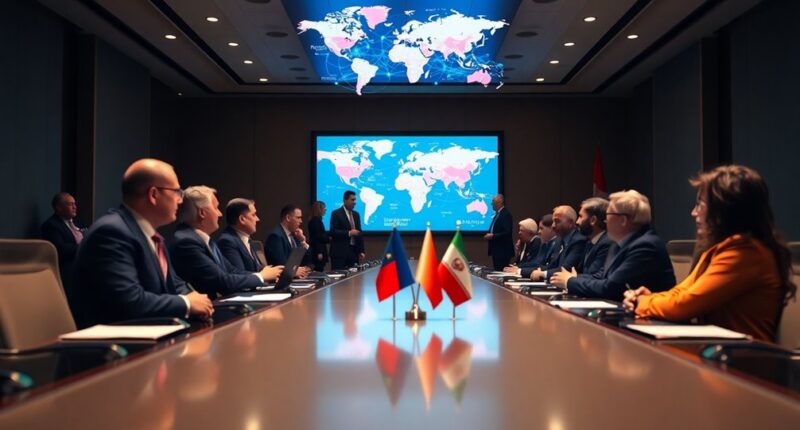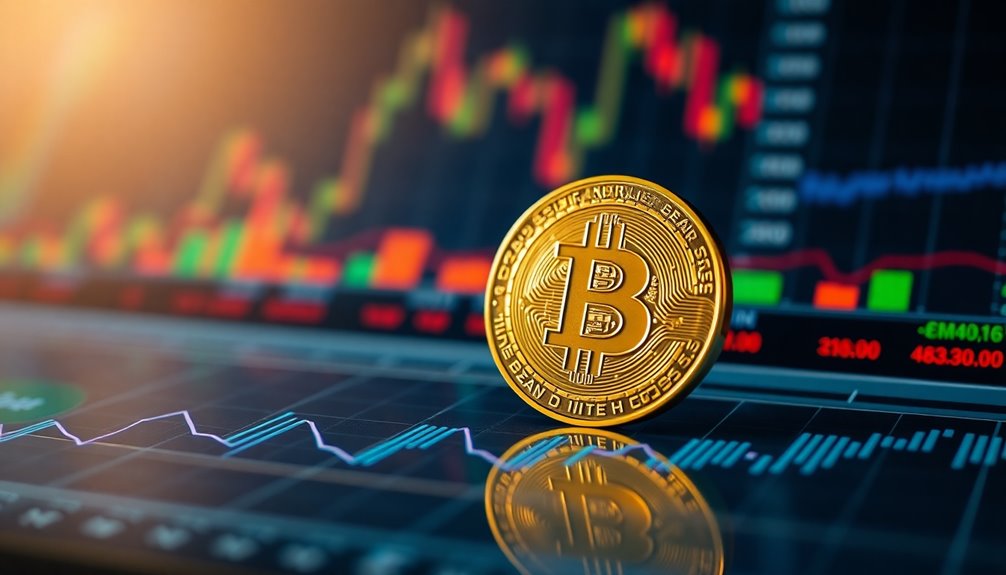Russia and Iran have announced a new financial messaging system to replace SWIFT, aiming to boost trade and counter economic sanctions. This initiative connects Russia's SPFS with Iran's emerging payment system, enhancing financial collaboration between the two nations. By featuring about 700 Russian banks and others from various countries, the system promotes using national currencies in transactions. This change could shift global payment dynamics, impacting how international trade is conducted. If you're curious about how this development might reshape economic relationships and the future of international payments, there's much more to explore.
Key Takeaways
- Russia and Iran are developing a new financial messaging system to facilitate trade and counteract US sanctions affecting their economies.
- The system integrates Russia's SPFS and Iran's SEPAM, promoting the use of national currencies for trade transactions.
- Approximately 700 Russian banks and 106 foreign banks are expected to participate in this new payment framework.
- This initiative aims to enhance economic collaboration, targeting a 15.5% increase in trade between the two nations by late 2024.
- The shift away from SWIFT could alter global trade dynamics and encourage the adoption of alternative payment systems worldwide.
Background and Context
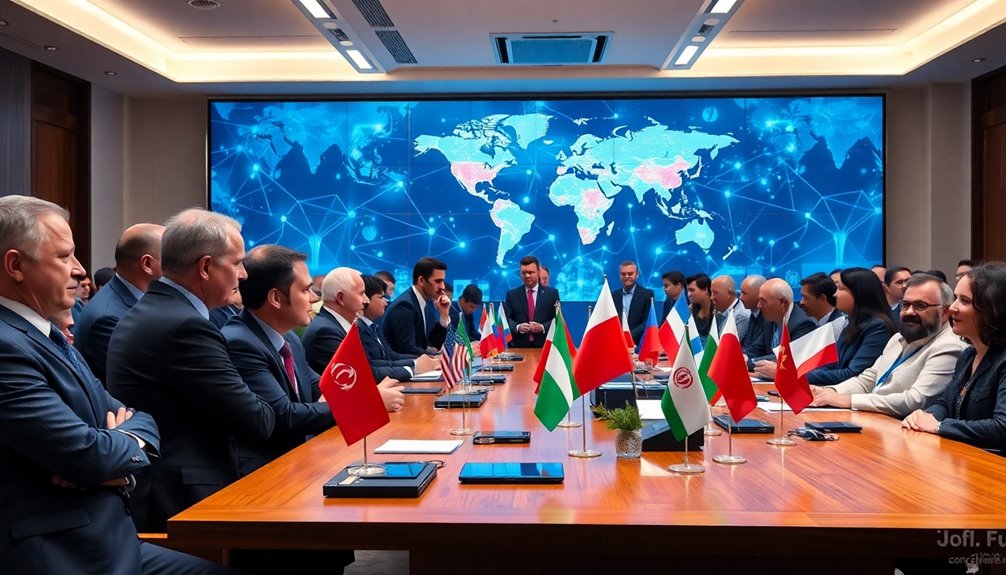
As global tensions rise, you might wonder how countries like Russia and Iran have adapted to their disconnection from the SWIFT system.
Both nations faced significant economic isolation due to sanctions, pushing them to seek alternatives for cross-border payments.
Iran was cut off from SWIFT in 2012 and again in 2018, while Russia's banks faced a similar fate after the invasion of Ukraine.
In response, they've deepened economic ties, developing their own financial messaging systems like Iran's SEPAM and Russia's SPFS. Russian banks previously excluded from SWIFT have also been linked to Iranian banking systems to further enhance their trade capabilities.
By integrating these systems, they aim to facilitate trade and settle payments in their national currencies, reducing reliance on the US dollar.
This collaboration could reshape the global payment landscape.
Announcement of the New System
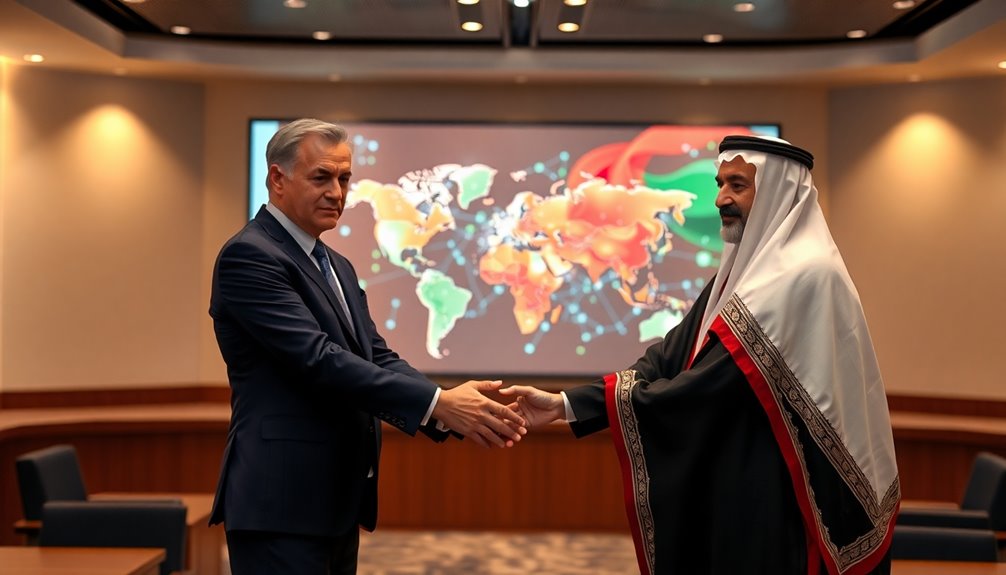
In response to their exclusion from the SWIFT system, Russia and Iran are moving forward with a new financial messaging system designed to enhance their economic collaboration.
Russia has been developing the System for Transmitting Financial Messages (SPFS) since 2014, while Iran is creating a similar system to connect with it.
The integration of these systems will enable interbank communication, allowing about 700 Russian banks and 106 non-Russian banks from 13 different countries to participate.
This alternative to SWIFT promotes the use of national currencies, such as the rouble and Iranian rial, for trade transactions. Furthermore, Iran will soon accept Russia's Mir payment network, signaling a strategic shift in their financial interactions.
As these nations collaborate on their payment systems, the potential emergence of a robust alternative to SWIFT could reshape the landscape of global finance, particularly as BRICS nations seek to reduce dollar reliance.
Global Payment Impact

While the shift toward alternative financial systems may seem daunting, the global payment landscape is evolving rapidly.
You'll notice that disconnecting Russia from SWIFT creates inefficiencies in cross-border payments, pushing them to explore new messaging systems.
Although SWIFT handles a staggering $140 trillion in transactions annually, alternatives like CIPS and SPFS manage less than half a percent of that volume.
The impact of sanctions from the U.S. and EU has further complicated matters for Russian and Iranian banks. However, their banking systems are now linked, enabling smoother transactions.
As these nations develop joint financial systems, you can expect significant changes in trade dynamics and currency usage—potentially altering the geopolitical landscape of global payments in the years to come. This initiative is part of a broader strategy to counter Western sanctions that has pushed both countries to enhance their financial collaboration.
Current Alternatives to SWIFT
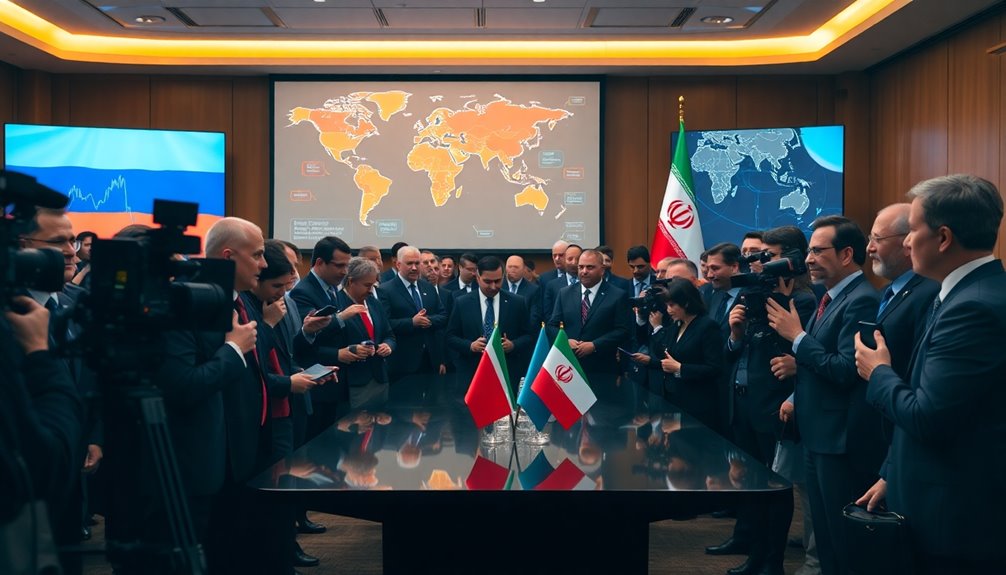
With the increasing need for alternatives to SWIFT, various payment solutions have emerged to meet the demands of a changing global landscape.
You can explore options like ACH and SEPA, which facilitate faster, cheaper transfers in specific regions.
Fintech services, such as Wise and Remitly, offer competitive rates and user-friendly platforms for quick transactions.
If you're interested in modern technology, blockchain and cryptocurrency platforms provide secure, borderless payments without intermediaries. SWIFT acts as a global messaging network, making it essential for understanding the landscape of international payment solutions.
International card networks like Visa and Mastercard also serve as convenient options, though they might rely on SWIFT infrastructure.
Finally, fintech service providers enhance traditional banking with real-time tracking and pre-funding for instant payments, allowing you to streamline overseas transactions effectively.
Geopolitical Implications
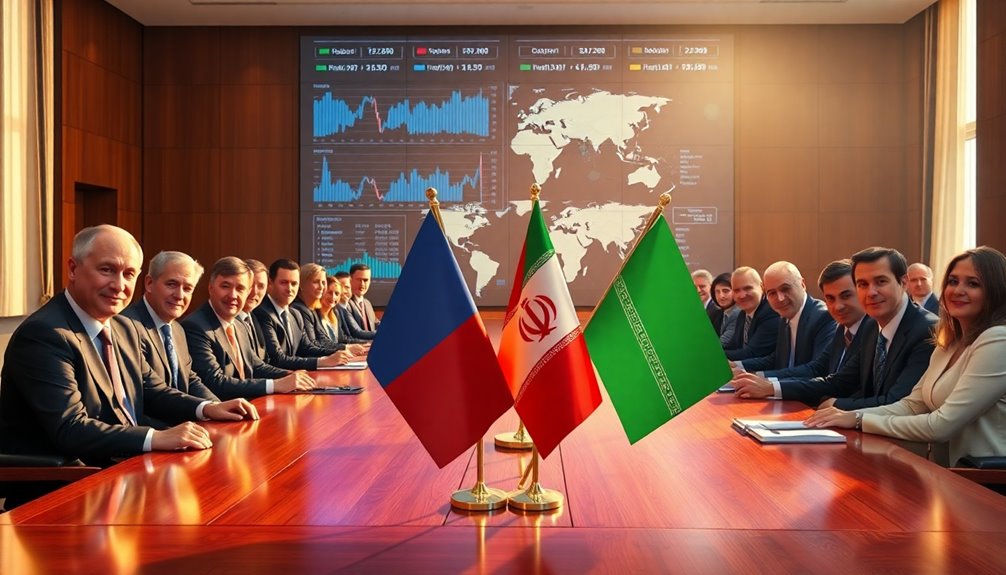
As Russia and Iran forge closer ties to create alternatives to SWIFT, the geopolitical landscape is shifting significantly. You'll notice both nations are aiming to reduce their dependence on the US dollar, promoting trade in their national currencies. This move could lead to increased trade with non-Western countries, altering global trade patterns. Moreover, their partnership is forming strategic alliances, like Iran's accelerated bid to join the Shanghai Cooperation Organisation, countering Western influence in Eurasia. While facing Western sanctions, both countries are deepening economic cooperation, which might spark economic growth despite challenges. This alliance not only emphasizes the vulnerabilities of the US dollar but also reflects a significant realignment of power dynamics on the global stage. Additionally, the emergence of two distinct financial systems—Western and Eastern—could further complicate international trade relations.
Financial Integration of Russia and Iran

Russia and Iran are rapidly enhancing their financial integration to establish a robust alternative to the SWIFT system.
They've connected their interbank communication systems, allowing fund transfers between over 700 Russian banks and 106 non-Russian banks. This move, confirmed by the Deputy Governor of Iran's Central Bank, enables Iranian banks to operate without SWIFT for transactions with Russian counterparts. Disconnection from SWIFT could also enhance the efficiency of their cross-border payments.
Additionally, the integration of Iran's Shetab network with Russia's Mir payment system lets you use Iranian bank cards in Russia and vice versa.
Both countries are also settling trade payments in national currencies, minimizing reliance on the US dollar.
This deepening partnership is a strategic response to Western sanctions, aiming to ensure economic stability for both nations.
Cost Reduction Strategies

The growing financial integration between Russia and Iran presents an opportunity for businesses to adopt cost reduction strategies that can enhance profitability.
Start by negotiating with your bank to secure lower fees for high-volume transactions, customizing fee structures, and benefiting from volume-based discounts.
Consolidate payments to reduce the number of transactions, leading to lower overall costs and simplified accounting.
Explore SWIFT alternatives like Xflow, which offer lower all-inclusive fees, no SWIFT charges, and faster processing times. Additionally, businesses should be aware that using alternative payment platforms can significantly reduce transaction costs compared to traditional methods. Tokenization can also play a crucial role in optimizing asset management and further reducing expenses.
Leverage local payment networks to cut down on intermediary fees and enjoy instant transfers.
Future Trends in Payments
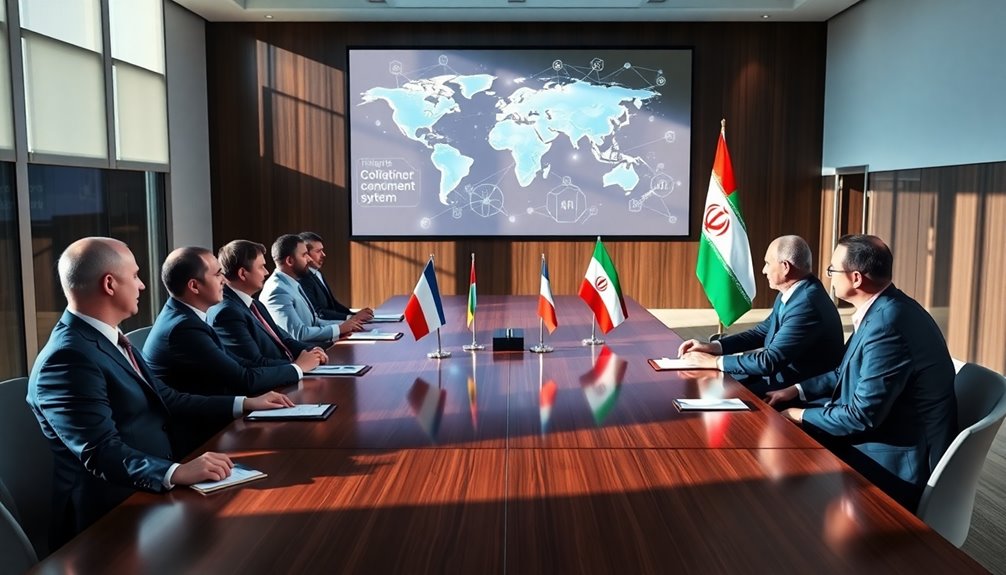
What's shaping the future of payments? Real-time payments are taking center stage, with initiatives like SEPA Instant Payments set to launch in Europe by October 2025. This trend caters to younger consumers who prefer instant transactions over traditional credit cards. AI adoption is also on the rise, with banks leveraging AI models to modernize payment processes and enhance productivity. AI technologies can streamline payment processing and enhance security, thus driving further innovation in the financial sector. Notably, cybersecurity vulnerabilities can be exacerbated during widespread outages, underscoring the importance of robust security measures in payment systems. Open banking is another game changer, promoting pay-by-bank solutions that offer instant transfers and reduce cart abandonment in e-commerce. Additionally, cross-border payments are evolving thanks to blockchain technology and fintech services, making international transactions faster and cheaper. Together, these trends are transforming how you manage and execute payments in an increasingly digital world.
Digital Currency Innovations
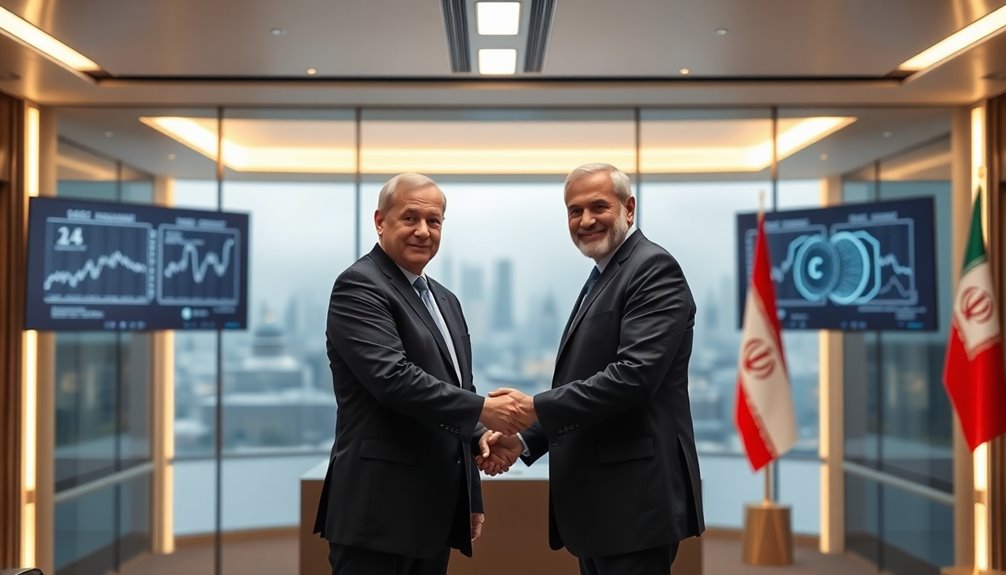
As digital currencies continue to evolve, innovations are reshaping how you think about transactions and finance.
XRP is revolutionizing global finance with near-instant, low-cost cross-border payments, gaining traction among Japanese banks. Nearly 80% of Japanese banks have integrated XRP into their operations to enhance transaction efficiency.
Meanwhile, Solana impresses with its blazing transaction speeds and a bustling ecosystem, launching over 250,000 new tokens weekly.
Chainlink acts as a trusted bridge between blockchain technology and traditional systems, processing over 10.6 billion data points and facilitating $8.7 trillion in transacted value.
Additionally, AI-driven cryptocurrencies are enhancing problem-solving capabilities through decentralized networks, transforming industries like healthcare and finance.
These advancements signal a shift toward more efficient, secure, and innovative financial transactions, making your engagement with digital currencies more impactful than ever.
Strategic Economic Partnerships

Digital currency innovations are reshaping the financial landscape, paving the way for new strategic economic partnerships.
Russia and Iran's treaty focuses on enhancing trade, aiming for a 15.5% increase to $3.77 billion by late 2024. By promoting financial collaboration, they seek to counter US sanctions and encourage reciprocal exports and investments. The anticipated signing of the treaty on January 17, 2025 underscores the commitment to strengthen their economic ties.
The agreement also emphasizes cooperation in agriculture and water management. Beyond economics, the treaty fosters academic, cultural, and sports initiatives, enriching ties between the two nations.
Security collaboration targets international crime and intelligence sharing, while regional cooperation through organizations like the UN and SCO strengthens their global positions.
This comprehensive partnership sets a foundation for mutual growth and resilience against external pressures.
Frequently Asked Questions
How Will This System Affect Small Businesses in Russia and Iran?
This new payment system could significantly impact your small business by reducing dependence on the US dollar, lowering transaction costs, and improving trade volume.
You'll likely find it easier to access international markets with enhanced security features and more user-friendly interfaces.
Additionally, the focus on local currencies may stabilize exchange rates and minimize currency risks, allowing you to operate with greater confidence and potentially increase your revenue from expanded trade opportunities.
Will Other Countries Join Russia and Iran's Payment System?
You might see other countries joining Russia and Iran's payment system, especially those seeking alternatives to Western financial networks.
Countries with close economic ties or facing sanctions could find the integration appealing. As technical challenges are addressed, and economic incentives grow, nations like Turkey or those in BRICS may consider participation.
This shift could foster greater financial independence and collaboration among countries looking to diversify their payment options and enhance regional trade.
What Are the Security Measures for the New Payment System?
Imagine setting up a new payment system, and security's your top concern.
You'll want to restrict internet access to crucial systems, ensuring they're physically secure.
Implement least-privilege access controls and use multi-factor authentication for added protection.
Encrypt sensitive data and maintain detailed access logs to monitor transactions.
Regular audits and a clear incident response plan will keep you prepared.
Train your employees on cybersecurity awareness, so they're equipped to handle potential threats effectively.
How Does This Impact Consumers in Both Countries?
This shift impacts you by potentially lowering transaction costs, making international purchases cheaper.
You'll likely see reduced reliance on the US dollar, which could stabilize prices of imported goods. As local currencies strengthen, you might benefit from more affordable imports.
Additionally, increased access to international markets could enhance the variety of goods available.
Can This System Compete With Established Global Payment Networks?
You might wonder if this new payment system can really compete with established networks like SWIFT. It connects numerous banks and offers a regional focus, which could streamline transactions.
However, while transaction costs are lower than some alternatives, they're still higher than fintech options. Plus, transaction speeds can lag behind what consumers expect.
Conclusion
As Russia and Iran roll out their alternative to SWIFT, the landscape of global payments is shifting like sand beneath your feet. This move not only challenges established systems but also opens doors to new economic partnerships and innovative digital currencies. As you navigate this evolving terrain, keep an eye on the ripples it creates in international relations and trade. The future of payments is unfolding, and it's time to adapt to this new rhythm of commerce.
